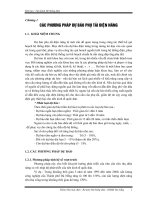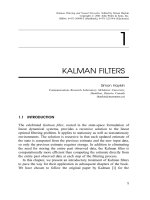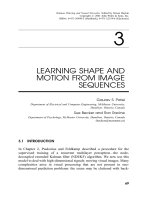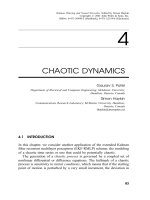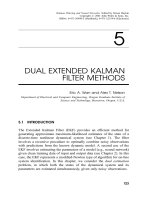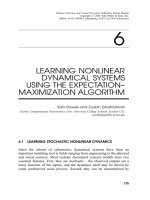Tài liệu Mobile Wireless and Sensor Networks P1 doc
Bạn đang xem bản rút gọn của tài liệu. Xem và tải ngay bản đầy đủ của tài liệu tại đây (561.12 KB, 40 trang )
MOBILE, WIRELESS, AND
SENSOR NETWORKS
TECHNOLOGY, APPLICATIONS,
AND FUTURE DIRECTIONS
Edited by
Rajeev Shorey
IBM Research
Indian Institute of Technology
A. Ananda
Mun Choon Chan
Wei Tsang Ooi
National University of Singapore
A JOHN WILEY & SONS, INC., PUBLICATION
This is a timely, readable and comprehensive survey of recent work in the
area of mobile networks, providing a good background reader for students
and practitioners alike. It highlights some of the opportunities and challenges
that accompany the deployment of both current wireless LANs as well as
next-generation mesh and multihop networks.
Henning Schulzrinne
Professor and Chair, Dept. of Computer Science
Columbia University, New York, USA
This book complements other publications in an are a that is of significant
interest in research and deployment these days and as such is welcome
and timely. By covering both technology and applications it is a useful hand-
book for people interested in both aspects of this field. The various topics are
represented in nicely connected chapters, each represent ing previously
unpublished work. The chapter authors are authorities.
Imrich Chlamtac
President, CreateNet Research Consortium
Bruno Kessler Honorary Professor
University of Trento, Italy
This book will get the reader started with what is happening on the research
front in the area of wireless LANs, multihop ad hoc and sensor networks. And
surely, once the reader goes through some of the chapters, she will want to
explore deeper the subjects covered and the issues addressed in the book.
These include performance analysis, design methodology, and middleware,
energy management, security, and applications.
Bijendra Jain
Professor, Dept. of Computer Science and Engg.
Indian Institute of Technology, Delhi, India
With contributions from several experts in the field, this collection of papers
provides an easily accessible, comprehensive and up-to-date coverage of the
vast and ever growing literature in several important areas of wireless net-
working, particularly, wireless LANs, multihop wireless networks, and wire-
less ad hoc sensor networks. The educator, the practitioner, and the
researcher will all find this book very useful.
Anurag Kumar
Professor and Chairman, Dept. of Electrical Communication Engg.
Indian Institute of Science, Bangalore, India
This book comprehensively addresses the fundamental problems in the
emerging area of mobile, wireless and sensor networks. The careful choice
of articles, and the lucid and technically sound way in which they are
authored, make this book particularly valuable for researchers who wish to
work in this exciting area.
Nisheeth Vishnol
IBM Research, India and
Georgia Institute of Technology, Atlanta, USA
With the proliferation of all sorts of wireless technologies empowering a wide
spectrum of personal to enterprise applications and services, research and
development in the related areas has experienced a very healthy growth
since the early 1990s and shows no signs of slowing down. With this as a
factual backdrop, this book presents a collection of contributions from leading
experts from the industry and academia presenting the latest and forward
looking trends in research and development in this area. The book logically
organizes the presentation of wireless, ad-hoc, and sensor network activities
and then ties them with value-add middleware which exposes the essence of
these networks to an intelligent set of application. The thesis of this book,
organized in 15 chapters, is presented in an advanced and rigorous yet
approachable manner that will surely benefit newcomers and seasoned
researchers and practitioners alike. I commend the editors for putting together
a well-thought and well-prepared book that further enriches the intellectual
capital of this maturing yet persistently young and challenging research area.
Chatschik Bisdiklan, PhD and IEEE Fellow
IBM T. J. Watson Research Center, New York, USA
This book, written by experts in the field, does an excellent job of covering the
latest developments in wirel ess and sensor networks. It is a must-read for
both researchers and industry professionals working in this emergi ng area.
Kumar Sivarajan
CTO, Tejasnetworks
Bangalore, India
The advent of mobile wireless and sensor networks is likely to have a huge
impact on society. This collection of contributed papers from eminent experts
in the field is indeed timely, and will serve as an excellent reference to stu-
dents, researchers, and practitioners in the field.
Sanjay Shakkottal
Assistant Professor, Department of Electrical and Computer Engg.
University of Texas at Austin, USA
The editors of Mobile,Wireless, and Sensor Networks have done a fabulous job
in compiling the latest advances in wireless networking research into a single
volume that will be of great use to students, faculty, and researchers alike.
Each chapter provides a good overview of the subject area, with a heady
mix of algorithms, results, and the underlying theory, woven tightly with sim-
ple explanations and supported by a large number of references. It is a must-
have text for anyone considering research in this field.
Thyaga Nandagopal
Communication Protocols and Internetworking Research
Bell Laboratories, Lucent Technologies, New Jersey, USA
MOBILE, WIRELESS, AND
SENSOR NETWORKS
MOBILE, WIRELESS, AND
SENSOR NETWORKS
TECHNOLOGY, APPLICATIONS,
AND FUTURE DIRECTIONS
Edited by
Rajeev Shorey
IBM Research
Indian Institute of Technology
A. Ananda
Mun Choon Chan
Wei Tsang Ooi
National University of Singapore
A JOHN WILEY & SONS, INC., PUBLICATION
Copyright # 2006 by John Wiley & Sons, Inc. All rights reserved.
Published by John Wiley & Sons, Inc., Hoboken, New Jersey.
Published simultaneously in Canada.
No part of this publication may be reproduced, stored in a retrieval system, or transmitted in any form or
by any means, electronic, mechanical, photocopying, recording, scanning, or otherwise, except as
permitted under Section 107 or 108 of the 1976 United States Copyright Act, without either the prior
written permission of the Publisher, or authorization through payment of the appropriate per-copy fee to
the Copyright Clearance Center, Inc., 222 Rosewood Drive, Danvers, MA 01923, 978-750-8400,
fax 978-646-8600, or on the web at www.copyright.com. Requests to the Publisher for permission should
be addressed to the Permissions Department, John Wiley & Sons, Inc., 111 River Street, Hoboken,
NJ 07030, (201) 748-6011, fax (201) 748-6008 or online at />Limit of Liability/Disclaimer of Warranty: While the publisher and author have used their best efforts
in preparing this book, they make no representations or warranties with respect to the accuracy or
completeness of the contents of this book and specifically disclaim any implied warranties of
merchantability or fitness for a particular purpose. No warranty may be created or extended by sales
representatives or written sales materials. The advice and strategies contained herein may not be suitable
for your situation. You should consult with a professional where appropriate. Neither the publisher
nor author shall be liable for any loss of profit or any other commercial damages, including but not
limited to special, incidental, consequential, or other damages.
For general information on our other products and services please contact our Customer Care Department
within the U.S. at 877-762-2974, outside the U.S. at 317-572-3993 or fax 317-572-4002.
Wiley also publishes its books in a variety of electronic formats. Some content that appears in print,
however, may not be available in electronic format.
Library of Congress Cataloging-in-Publication Data:
Mobile, wireless, and sensor networks: technology, applications, and future directions/edited by
Rajeev Shorey. . . [et al.].
p. cm.
Includes bibliographical references.
ISBN-13 978-0-471-71816-1 (cloth: alk. paper)
ISBN-10 0-471-71816-5 (cloth: alk. paper)
1. Wireless communication systems. 2. Wireless LANs. 3. Mobile communication
systems. 4. Sensor networks. I. Shorey, Rajeev.
TK103.2.M634 2006
621.382
0
1–dc22 2005010792
Printed in the United States of America
10987654321
Dedicated to my mother, wife and daughters, and,
my teachers and friends — Rajeev Shorey
Dedicated to the lineage of gurus — A. L. Ananda
To my wife and daughter — Mun Choon Chan
To my parents — Wei Tsang Ooi
CONTENTS
FOREWORD ix
PREFACE xi
CONTRIBUTORS xv
PART I RECENT ADVANCES IN WLANs
AND MULTIHOP WIRELESS NETWORKS
1. Measuring Wireless LANs 5
Tristan Henderson and David Kotz
2. Understanding the Use of a Campus Wireless Network 29
David Schwab and Rick Bunt
3. QoS Provisioning in IEEE 802.11 WLAN 45
Sunghyun Choi and Jeonggyun Yu
4. A Perspective on the Design of Power Control for Mobile
Ad Hoc Networks 73
Alaa Muqattash, Marwan Krunz, and Sung-Ju Lee
5. Routing Algorithms for Energy-Efficient Reliable Packet
Delivery in Multihop Wireless Networks 105
Suman Banerjee and Archan Misra
PART II RECENT ADVANCES AND RESEARCH
IN SENSOR NETWORKS
6. Detection, Energy, and Robustness in Wireless
Sensor Networks 145
Lige Yu and Anthony Ephremides
7. Mobile Target Tracking Using Sensor Networks 173
Ashima Gupta, Chao Gui, and Prasant Mohapatra
vii
8. Field Gathering Wireless Sensor Networks 197
Enrique J. Duarte-Melo and Mingyan Liu
9. Coverage and Connectivity Issues in Wireless Sensor Networks 221
Amitabha Ghosh and Sajal K. Das
10. Storage Management in Wireless Sensor Networks 257
Sameer Tilak, Nael Abu-Ghazaleh, and Wendi B. Heinzelman
11. Security in Sensor Networks 283
Farooq Anjum and Saswati Sarkar
PART III MIDDLEWARE, APPLICATIONS,
AND NEW PARADIGMS
12. WinRFID: A Middleware for the Enablement of Radiofrequency
Identification (RFID)-Based Applications 313
B. S. Prabhu, Xiaoyong Su, Harish Ramamurthy, Chi-Cheng Chu,
and Rajit Gadh
13. Designing Smart Environments: A Paradigm Based on
Learning and Prediction 337
Sajal K. Das and Diane Cook
14. Enforcing Security in Mobile Networks: Challenges
and Solutions 359
Feng Bao, Robert H. Deng, Ying Qiu, and Jianying Zhou
15. On-Demand Business: Network Challenges in a Global
Pervasive Ecosystem 381
Craig Fellenstein, Joshy Joseph, Dongwook Lim, and J. Candice D’Orsay
INDEX 409
viii CONTENTS
FOREWORD
Wireless networking could possibly be at the cusp of a takeoff. Scarcely a day
passes without an email announcement of another wireless networking conference.
This, of course, is a manifestation of the intense researc h activity in the filed. In
such a dynamic environment there is a definite need for carefully organized
collections of papers that organized the research output in a coherent way. This
is useful not only for new entrants but also for active researchers in the area in
keeping abreast of developments not within the immediate sphere of their
investigations. The present book is just such an effort, and includes contributions
from several well-known researchers in wireless networking. It features carefully
written articles covering topics of much current interest in the areas of wireless
local area networks (WLANs), multihop networks, sensor networks, and middle-
ware. Through these expert contributions, it serves a useful and timely role in the
reduction to entropy, and thus the assimilation of the research output, thereby
furthering evolution of the field of wireless networking.
P. R. K
UMAR
University of Illinois
Urbana–Champaign
May 13, 2005
ix
PREFACE
Objectives
The market for wireless communications has enjoyed tremendous growth. Wireless
technology now reaches or is capable of reaching virtually every location on the
face of the earth. Hundreds of millions of people exchange information every day
using laptops, personal digital assistants (PDAs), pagers, cellular phones, and other
wireless communication devices. Success of outdoor and indoor wireless commu-
nication networks has led to numerous applications in sectors ranging from
industries and enterprises to homes and universities. No longer bound by the
harnesses of wired networks, people are able to access and share information on a
global scale nearly anywhere they venture.
Some of the most remarkable growth has occurred in the deployment of wireless
LANs (WLANs) where IEEE 802.11 based wireless networks have been used to
provide connectivity not only as hotspots but also to substantial portions of a city.
At the same time, we are also witnessing a significant trend in the emergence of
small and low-cost computation and communication devices. While these tiny
devices, called sensor nodes, are tightly constrained in terms of energy, storage
capacity, and data processing capability, they have the potential to serve as a
catalyst for a major change in how we communicate and interact with the
environment.
This book aims to address challenging issues in wireless networks, in particular,
wireless LANs, multihop wireless networks, sensor networks and their applications.
In addition, the book discusses emerging applications and new paradigms, for
example, middleware for RFID, smart home design, and ‘‘on-demand business’’ in
the context of pervasive computing.
The objective of the book is twofold: to bridge the gap between practice and
theory and between different types of related wireless networks.
We believe that the theme and focus of the book is timely. The book focuses on
important topics of current interest in wireless, mobile, and sensor networks and
covers issues ranging from architecture, protocols, modeling and analysis to new
applications, solutions, and emerging paradigms.
To the best of our knowledge, there is no existing book that brings together
closely related topics in a single volume and that discusses key technical challenges
along with important applications. The chapters of the book are written by
researchers and practitioners from academia and industry who are experts in the
xi
field. In most of the chapters, the authors begin with a broad survey of the topic and
then move on to discuss the technical challenges and solutions.
Intended Audience
This book should serve as an excellent source of information for students,
researchers, and practitioners who want to track new research and developments
in wireless communication but do not have time or patience to read numerous
papers and specifications. The book will be very useful to research students who are
looking for open problems in this space. In addition, the book also targets
professionals in the field of wireless/mobile communications, designers, and
networking managers.
How Did the Idea of the Book Originate?
The idea of this book was conceived in March of 2004, when we conducted a highly
successful international workshop in Singapore titled ‘‘MOBWISER’’ (Mobile,
Wireless and SensoR Networks: Technology and Future Direc tions). The readers
are encouraged to see the Website
.
edu.sg/
for more details.
The workshop had 13 invited experts from all over the world to present their
work in areas ranging from multihop wireless networks to sensor networks and their
applications. The workshop was a great success in every respect. It was attended by
more than 125 delegates. Encouraged by the success of the workshop and the
enthusiasm of the attendees, the editors decided to put together a book in this area
that would address core issues in wireless networks, with emphasis on wireless
LANs, multihop wireless networks, and sensor networks, along with their applica-
tions.
When we approached MOBWISER workshop speakers to contribute a paper to
the book, many of them generously agreed. We are extremely grateful to Sunghyun
Choi, Sajal Das, Robert Deng, Anthony Ephremides, Craig Fellenstein, Marwan
Krunz, Mingyan Liu, Archan Misra, and Prasant Mohapatra for their enthusiasm
and interest in this project from a very early stage.
As the book became a reality, we realized the need to include additional topics in
the text in order to present a more complete and broader scope. The new topics
added were wireless LAN measurements, security in mobile networks, security and
storage management in sensor networks, and sensor-network-related middleware
and applications. We are extremely thankful to Farooq Anjum, Rick Bunt, Rajit
Gadh, Wendi Heinzelman, and David Kotz for their contribution to the book.
Acknowledgments
A good book is always a collective effort of many people. In addition to the authors
of the 15 chapters, we would like to especially thank Professors Sajal Das and
xii PREFACE
Anthony Ephremides, who were instrumental in initiating the idea of this book. We
greatly appreciate their constant encouragemen t and support in this project.
Since the idea of this book originated during the MOBWISER workshop, we
would like to thank Mr. Yap Siang Yong and Ms. Sarah Ng at the National
University of Singapore for their excellent support in organizing the MOBWISER
workshop in Singapore in March 2004. We would like to thank our organizations —
the National University of Singapore and IBM India Research Laboratory, New
Delhi for their generous support for this project and for allowing us to use the
resources in the organizations.
A special thanks to the staff at John Wiley in Hoboken, New Jersey (USA), who
have been wonderful. Our thanks go to Val Moliere and Emily Simmons for their
encouragement, patience, and excellent support throughout this project. This book
would not have been possible without their help, and we are greatly indebted to
them. Working with Val and Emily has been a very pleasant and memorable
experience, and we thank them for an outstanding job.
Organization of the Book
This book is split into three logically distinct parts. Part I describes more recent
advances in wireless LANs and multihop wireless networks. Part II is devoted to
recent advances and research in wireles s sensor networks. The topics covered in the
Part III are RFID middleware, smart home environments, security in mobile
networks, and on-demand business.
It is expected that the reader will follow the chapters in each part in sequence so
as to gain a better understandin g of the subject. The three parts of the book can be
read in any order.
We hope the readers will find thi s unique book interesting and useful in gaining a
deeper insight into the fascinating subject of ‘‘mobile, wireless, and sensor’’
networks.
R
AJEEV SHOREY
IBM, New Delhi
November 1, 2005
AKKIHEBBAL L. ANANDA,
M
UN CHOON CHAN, AND
WEI TSANG OOI
NUS, Singapore
November 1, 2005
PREFACE xiii
CONTRIBUTORS
Nael Abu-Ghazaleh, Department of Computer Science, Watson School of
Engineering and Applied Sciences, Binghampton University, Binghampton,
NY 13902
Farooq Anjum, Applied Research, Telcordia Technologies, One Telcordia Drive,
Piscataway, NJ 08854
Suman Banerjee, Department of Computer Sciences, University of Wisconsin,
Madison, WI 53706
Feng Bao, Institute for Infocomm Research, 21 Heng Mui Keng Terrace, Singa-
pore 119613
Rick Bunt, University of Saskatchewan, E234 Administration Building,
105 Administration Place, Saskatoon S7N 5A2, Canada
Sunghyun Choi, School of Electrical Engineering, Seoul National University,
Kwanak, P. O. Box 34, Seoul 151-600, Korea
Chi-Cheng Chu, University of California at Los Ange les, Wireless Internet for the
Mobile Enterprise Consortium (WINMEC), 420 Westwood Place, Los Angeles,
CA 90095
Diane Cook, Department of Computer Science and Engineering, University of
Texas at Arlington, Arlington, TX 76019
Sajal K. Das, Department of Computer Science and Engineering, University of
Texas at Arlington, Arlington, TX 76019
Robert H. Deng, School of Information System, Singapore Management Uni-
versity, 469 Bukti Timah Road, Singapore 259756
J. Candice D’Orsay, IBM Global Services, Network Services (NS) Organization,
6 Hunting Ridge Road, Brookfield, CT 06804-3710
Enrique J. Duarte-Melo, Department of Electrical and Computer Engineering,
University of Michigan, Ann Arbor, MI 48109-2122
Anthony Ephremides, Department of Electrical and Computer Engineering,
University of Maryland, College Park, MD 20742
xv
Craig Fellenstein, IBM Global Services, Network Services (NS) Organization, 6
Hunting Ridge Road, Brookfield, CT 06804-3710
Rajit Gadh, University of California at Los Angeles, Wireless Internet for the
Mobile Enterprise Consortium (WINMEC), 420 Westwood Place, Los Angeles,
CA 90095
Amitabha Ghosh, Department of Computer Science and Engineering, University
of Texas at Arlington, Arlington, TX 76019
Ashima Gupta, Department of Computer Science, 2063 Kemper Hall, University
of California at Davis, Davis, CA 95616
Chao Gui, Department of Computer Science, 2063 Kemper Hall, University of
California at Davis, Davis, CA 95616
Wendi B. Heinzelman, Department of Electrical and Computer Engineering,
University of Rochester, Hopeman Building, P.O. Box 270126, Rochester,
NY 14627
Tristan Henderson, Department of Computer Science, 6211 Sudikoff Laboratory,
Dartmouth College, Hanover, NH 03755-3510
Joshy Joseph, IBM Global Services, Network Services (NS) Organization,
6 Hunting Ridge Road, Brookfield, CT 06804-3710
David Kotz, Department of Computer Scie nce, 6211 Sudiko ff Laboratory,
Dartmouth College, Hanover, NH 03755-3510
Marwan Krunz, Department of Electrical and Computer Engineering, University
of Arizona, Tucson, AZ 85721
Sung-Ju Lee, Mobile and Media Systems Lab, Hewlett-Packard Laboratories, Palo
Alto, CA 94304
Dongwook Lim, IBM Global Services, Network Services (NS) Organization,
6 Hunting Ridge Road, Brookfield, CT 06804-3710
Mingyan Liu, Department of Electrical and Computer Engineering, University of
Michigan, Ann Arbor, MI 48109-2122
Archan Misra, IBM T.J. Watson Research Center, 19 Skyline Dr ive, Hawthorne,
NY 10532
Prasant Mohapatra, Department of Computer Science, 2063 Kemper Hall,
University of California at Davis, Davis, CA 95616
Alaa Muqattash, Department of Electrical and Computer Engineering, University
of Arizona, Tucson, AZ 85721
B. S. Prabhu, University of California at Los Angeles, Wireless Internet for the
Mobile Enterprise Consortium (WINMEC), 420 Westwood Place, Los Angeles,
CA 90095
xvi CONTRIBUTORS
Ying Qiu, Institute for Infocomm Research, 21 Heng Mui Keng Terrace, Singa-
pore 119613
Harish Ramamurthy, University of California at Los Angeles, Wireless Internet
for the Mobile Enterprise Consortium (WINMEC), 420 Westwood Place, Los
Angeles, CA 90095
Saswati Sarkar, Applied Research, Telcordia Technologies, One Telcordia Drive,
Piscataway, NJ 08854
David Schwab, University of Saskatchewan, E234 Administration Building,
105 Administration Place, Saskatoon S7N 5A2, Canada
Xiaoyong Su, University of California at Los Angeles, Wireless Internet for the
Mobile Enterprise Consortium (WINMEC), 420 Westwood Place, Los Angeles,
CA 90095
Sameer Tilak, Department of Computer Science, Watson School of Engineering
and Applied Sciences, Binghampton University, Binghampton, NY 13902
Jeonggyun Yu, School of Electrical Engineering, Seoul National University,
Kwanak, P. O. Box 34, Seoul 151-600, Korea
Lige Yu, Department of Electrical and Computer Engineering, University of
Maryland, College Park, MD 20742
Jianying Zhou, Institute for Infocomm Research, 21 Heng Mui Keng Terrace,
Singapore 119613
CONTRIBUTORS xvii

